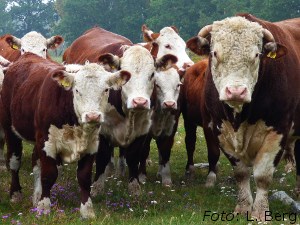Improved welfare of pigs and cattle at slaughter – evaluation and development of animal welfare indicators and their association to meat quality
Project leader: Anna Wallenbeck, Department of Animal Environment and Health, SLU Skara.
In collaboration with: Lotta (Charlotte) Berg, Anders Karlsson and Josefine Jerlstrom, Department of Animal Environment and Health, SLU Skara. Cecilia Lindahl and Ann-Kristina Lind, RISE. Paula Quintana Fernandez, KRAV.
Animal welfare, i.e. the subjective experience of the animal and its biological functioning and adaptation to its current environment, includes all parts of an animal’s life. Although the time spent at the slaughterhouse is a relatively short period of livestock’s life, it has a major influence on the welfare of the animals.
At a slaughterhouse, livestock are exposed to a number of novel stressful factors such as noises, odours and interactions with unfamiliar conspecifics and humans. Besides negative effects on animal welfare per se, stress in animals prior to slaughter has negative effects on meat and carcass quality. Although the relationships between suboptimal handling of animals, animal welfare and meat quality may seem at least partly self-evident, research in this area is lacking.
The long-term aim of this project is to improve welfare and meat quality of pigs and cattle from organic production systems. This three-year project will be conducted in three steps with the specific goals to
- map and validate animal welfare indicators in animals from organically certified herds on the slaughter site and assess association to meat quality,
- investigate how the welfare of the animals at slaughter and meat quality is affected by the rearing system, handling at transport and handling at the slaughterhouse and
- develop a protocol for monitoring of animal welfare based on the results from steps 1 and 2.
The project starts 2021
The project starts 2021
